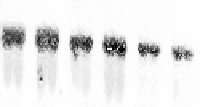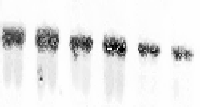Information Technology Reference
In-Depth Information
Degenerated oligonucleotides were designed based on regions of high homology
between aligned PE-deduced amino acid sequences from
Lycopersicon esculentum
were
used to amplify partial-length of papaya cDNA from reverse-transcribed RNA of mature
ripe (70 % yellow) fruit mesocarp of papaya. The amplified product was 649 bp, as
predicted from the sequences of known Pectinesterases. RT-PCR clones were cloned in
Bluscripts vector (Strategene) and were sequenced.
The cDNA library constructed from papaya fruit mRNA was screened using, as
probe, an insert from partial-length cDNA obtained by RT-PCR. The resulting cDNA clone
was 1620 bp in length and contained a complete open reading frame. The length of cDNA
clones correspond to the size of the most abundant corresponding mRNA, and it is assumed
that they represent full-length mRNAs. All the cDNAs contained complete open reading
frames
I E I E I E I E I E I E
I E I E I E I E I E I E
A
A
1 3 5 7 9 11
1 3 5 7 9 11
1 3 5 7 9 11
B
B
B
Figure 2.
PCR amplification of
PME using degenerated primer
Figure 3.
Northern Blotting of
Carica papaya total RNA using
papaya PME partial gene
The phylogram generated using an alignment of the deduced amino acid sequences
of papaya PME and of other 10 PMEs published primary aminoacid sequences from other
plant species is presented in fig.6. From this phylogram it can be observed that
pectinmethyl esterase from papaya fruits presents higher similarity (between 35 and 82%)
with tomato PME sequences than with the other PME sequences available.
The amount of total RNA in the mature ripe fruit (stages 9 and 11) duplicated the
amount of total RNA in the green fruit (stages 1 and 3) (fig.4). In all the stages of fruit
ripening, the amount of total RNA in the inner and in the outer mesocarp was similar (data
not shown).
Northern blot analysis was carried out to examine the level of mRNA expression in
fruit at different ripening stages. All the cDNAs were expressed at similar levels at the
inner and outer mesocarp tissues during the different stages of fruit ripening. However, its
expression was highest for ripening stages 1, 3, 5 and 7 decreasing thereafter (stages 9 and
11) to very low levels of expression (fig.4). These results show that increase in mRNA
translation parallels the increase in PME activity.
Cloning of a tomato fruit PME cDNA clone allowed the characterisation of mRNA levels
that are highest in immature green fruit and then decline throughout maturation and
ripening (Ray et al., 1988). This pattern of mRNA accumulation did not parallel the









